Identifying Authentic Vintage Clothing
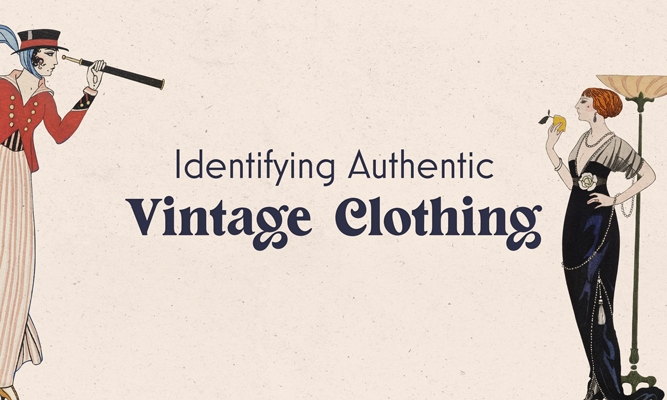
Vintage fashion is making a serious comeback. But with designers coming out with vintage silhouettes, how can you tell the difference between vintage and reproduction? I spoke with Selena, or the Vintage Bombshell, known for her vintage fashion and jewelry. She shared a few tips to help distinguish between the old and new.
Selena’s love and appreciation for vintage and secondhand items were ingrained in her at the start of her childhood. Weekends were spent shopping estate sales and garage sales with her parents. Selena’s dad taught her the difference between quality pieces and pressed wood. And her mom taught her how to refinish those pieces. Their home was filled with secondhand finds.
She has a YouTube channel devoted to her love of thrifting and a wardrobe full of secondhand clothing. While only 10% of her wardrobe is authentic vintage, Selena estimates that 90% of her clothing is secondhand. She is an expert in thrifting and has learned a few tricks along the way to help her identify authentic vintage clothing pieces and vintage jewelry. If you’re looking for genuine vintage clothing, these tips may help point you in the right direction.
Check the Zipper
The first thing Selena checks on a potential vintage piece of clothing is the zipper. Zippers were made to last in the 40s, 50s, and 60s and resembled those found on old sleeping bags. They had a square or rectangular pull, and the teeth and pull were all metal and industrial looking. Those are the zippers that typically have zero trouble zipping even seventy years after production. Higher quality fasteners can be found on most vintage pieces, so pay close attention to things like buttons, clasps, and snaps.
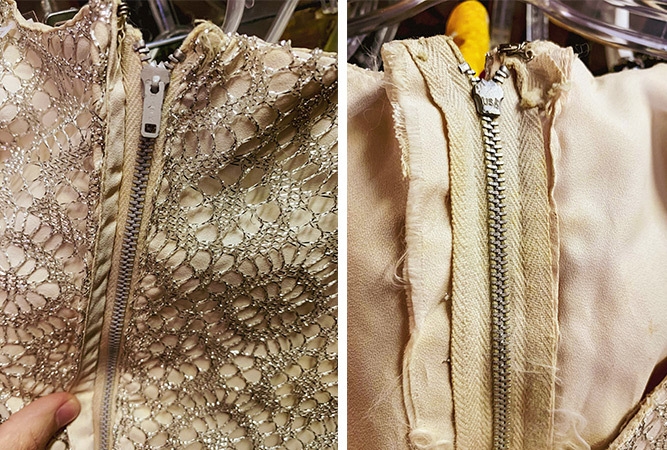
If authentic vintage pieces are important to you, avoid zipper pulls that resemble a grain of rice or plastic zippers. Many companies made the switch to plastic in the mid-60s. But some have recently switched back to metal zippers making it more challenging to spot truly vintage clothing. The following few tricks will help you tell the difference.
Check for US Union Stamp
Clothing made in the United States often contains a label sewn into the piece called a Union Label. It is easy to distinguish between modern and vintage labels because vintage ones have a scalloped circle around the words “INT’L. LADIES GARMENT WORKERS UNION” with the union logo in the middle. You will also find a series of numbers on pieces from the 50s up to the mid-60s.

If you find a garment with a union label with the letter R with a circle around it just below the scalloped emblem, the piece was made after 1964. That was the period when the union label was trademarked.
Garments found with a union label and without a scalloped circle were produced in 1995 or after. Some now consider the 90s vintage (I guess that makes me vintage), so it is up to you to decide what vintage style you want to look for!
Embroidered Label
When searching for vintage clothing, always look for the designer label. A good indicator that you have found genuine vintage is an embroidered label.
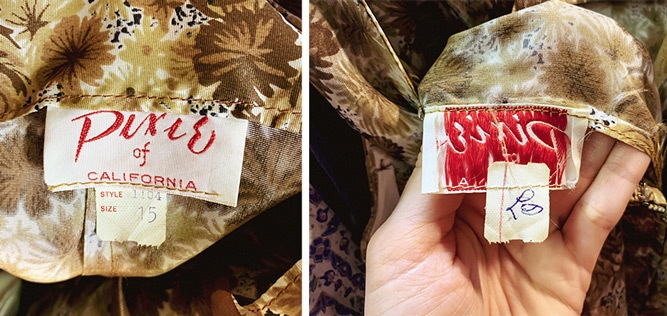
These labels will show threading on the back and will indicate the designer. Reproduction and modern pieces typically have a label printed on the fabric or the tag and will not be embroidered. This is a quick, easy way to identify old from new.
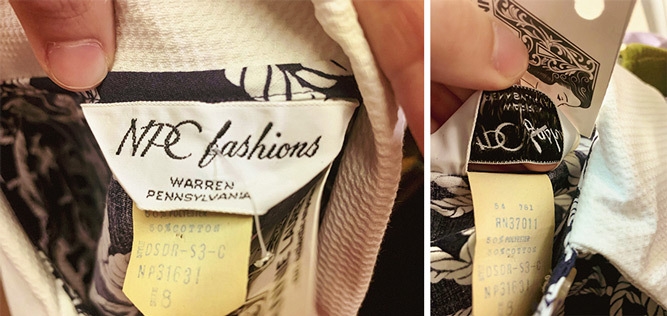
How to Care for Vintage Clothing
Vintage clothing has been around for decades and needs to be treated with care. Selena admits she has ruined many vintage pieces, and the worst part is, she can’t bring them back to life. Sometimes getting them wet will destroy the fabric or make dyes run. Always do a spot test in a discreet location to see if coloring bleeds.
Because women commonly wore slips underneath dresses and pads in the armpit areas, they could go several wears between washing. If this isn’t possible, treat your pieces very gently and consider dry cleaning whenever possible. “The worst thing is to be the end of something’s life,” Selena says, referring to the end of a vintage clothing piece’s life.
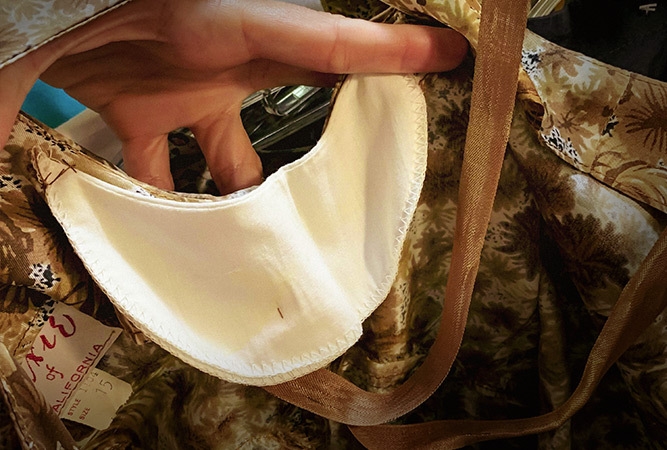
Selena notes that tulle vintage party dresses are easy to wash by hand. Her technique is to fill her bathtub up with cool water and add oxy-clean. Gently scrub the piece, then allow it to dry in the sun, says Selena. The sun will bring the colors back to life. Dry clean delicates, silk, or old novelty prints.
Where Selena Finds Vintage Clothing
As I mentioned earlier, nearly 90% of Selena’s wardrobe is secondhand. She is a serious thrifter and looks for deals almost daily. Her routine is to search online auctions, estate sales (EstateSales.NET, of course—wink wink), Craigslist, Facebook Marketplace, and local thrift stores. She’s lucky to live near Portland, OR, which has a tremendous vintage community. But she recommends checking out your local charity shops and antique stores to increase your chances of finding vintage clothing.
Selena’s tip for finding vintage at an estate sale is to look for sales in retirement areas and older homes. It often means an older person lives in the house, which could mean vintage clothing is inside.
The best tip Selena gave was to simply have fun with your search. It’s all about the thrill of the hunt for her. Stumbling upon a 40s or 50s style party dress is like winning the vintage lottery.
And if you like the look of vintage clothing but aren’t concerned if it’s authentic vintage or reproduction, you can find vintage styles and cuts just about anywhere nowadays. Selena loves vintage-style party dresses and doesn’t discriminate between vintage and reproduction when she finds that “ultimate feminine silhouette.” It’s really about how the piece makes you feel, and that’s what is most important.
To learn more about Selena and follow along on her hunts, check out her YouTube channel, The Vintage Bombshell. Or find her on Instagram, where she shares some of her clothing style and a lot of her Victorian home’s style. You can also check out her “Identifying Vintage Clothing” highlight on the EstateSales.NET Instagram profile if you’re out and about and need quick tips to identify pieces. Love all things estate sales? Us, too! Head over to our blog to learn about all things vintage, DIY, and more!